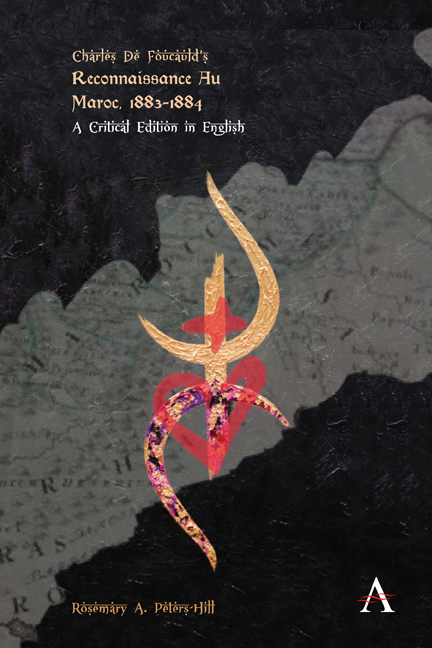Book contents
- Frontmatter
- Contents
- List of Figures
- Acknowledgments
- “There are no roads”: Charles de Foucauld’s Reconnaissance au Maroc—a Critical Introduction
- Charles de Foucauld, Reconnaissance au Maroc, 1883–1884
- Letter to François de Bondy
- Introduction
- Avant-Propos
- I Tangiers to Meknès
- II Meknès to Qaçba Beni Mellal
- III Qaçba Beni Mellal to Tikirt
- IV Tikirt to Tissint
- V Sojourn in the Sahara
- VI Tissint to Mogador
- VII Mogador to Tissint
- VIII Tissint to the Dadès
- IX The Dadès to Qçabi ech Cheurfa
- X Qçabi ech Chorfa to Lalla Maghnia
- Appendix: The Jews of Morocco
- Note on the Materials Used to Draw Up My Itinerary
- Report Delivered to the Société de Géographie de Paris in Its General Session of 24 April 1885
- “Itineraries in Morocco”
- Afterwards: An Afterword
- Glossary of Terms
- Bibliography
- Index
III - Qaçba Beni Mellal to Tikirt
Published online by Cambridge University Press: 20 January 2022
- Frontmatter
- Contents
- List of Figures
- Acknowledgments
- “There are no roads”: Charles de Foucauld’s Reconnaissance au Maroc—a Critical Introduction
- Charles de Foucauld, Reconnaissance au Maroc, 1883–1884
- Letter to François de Bondy
- Introduction
- Avant-Propos
- I Tangiers to Meknès
- II Meknès to Qaçba Beni Mellal
- III Qaçba Beni Mellal to Tikirt
- IV Tikirt to Tissint
- V Sojourn in the Sahara
- VI Tissint to Mogador
- VII Mogador to Tissint
- VIII Tissint to the Dadès
- IX The Dadès to Qçabi ech Cheurfa
- X Qçabi ech Chorfa to Lalla Maghnia
- Appendix: The Jews of Morocco
- Note on the Materials Used to Draw Up My Itinerary
- Report Delivered to the Société de Géographie de Paris in Its General Session of 24 April 1885
- “Itineraries in Morocco”
- Afterwards: An Afterword
- Glossary of Terms
- Bibliography
- Index
Summary
Qaçba Beni Mellal to Ouaouizert.
25 September 1883.— Departure at six-thirty in the morning. Three zetats accompany me, one from the Beni Mellal tribe, two from the Aït Atta d Amalou. Ouaouizert, where I am going, is located at the southern foot of the Middle Atlas, which separates the Tâdla plains from the course of the Oued el Abid and whose north slope I have followed since Tagzirt. I therefore have to climb over this range. Its hills are generally steep; as soon as they become gentle enough to support farming, fields cover them and dwellings appear, but these places are rare: almost all the sides are stiff and woody, and except for spaded-out spots, clearings scattered here and there, a thick forest adorns the sides of the massif. Lentisks, carob trees, and pines dominate; they reach a height of five to six meters. The ground is half earth, half rock; the latter not a long bedrock, here, but rather isolated blocks emerging from the earth between trees. Streams with running water irrigate both sides. The road, always mountainous, challenging everywhere, is very difficult in two places: first, upon exiting Qaçba Beni Mellal, at the passage called Aqba el Kharroub; then as we approach the pass, Tizi Ouaouizert, preceded by an extremely steep climb. At one o’clock, I reach Ouaouizert.
No important waterways along the road today. Few people on the road. The dwellings we encountered were very poor in appearance: sometimes small houses, two meters high, built of rammed earth, covered with flat roofs, most of them located halfway up the slope and halfway sunk into earth; and sometimes simple huts of branches; the few douars I saw were made up only of shacks arranged in a circle: no true tents.
Stay in Ouaouizert
Immediately after leaving Qaçba Beni Mellal, I entered into the territory of the Aït Atta d Amalou, in whose lands is located Ouaouizert. They have nothing in common with the Aït Atta of the Drâa, nor with the Berâber. They are a small Tamazight tribe (chleuha), independent, whose borders are: north, the Tâdla; south, the Oued el Abid; east, the Aït Seri; and west, the Aït Bou Zid.
- Type
- Chapter
- Information
- Charles de Foucauld’s Reconnaissance au Maroc, 1883–1884A Critical Edition in English, pp. 185 - 222Publisher: Anthem PressPrint publication year: 2020



